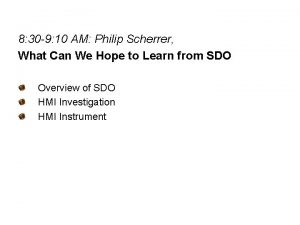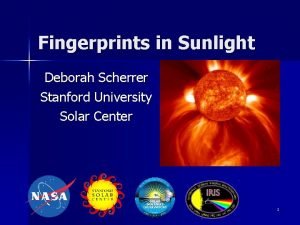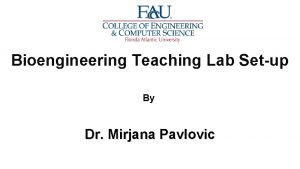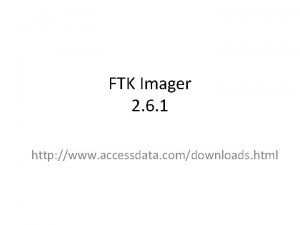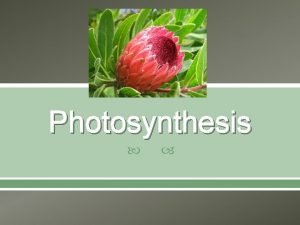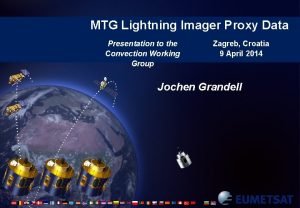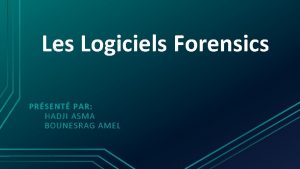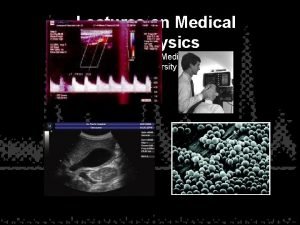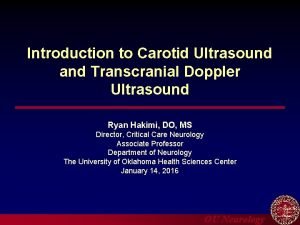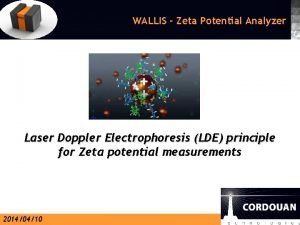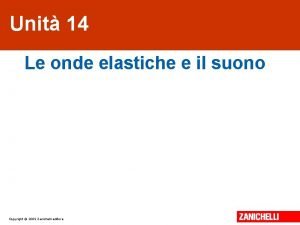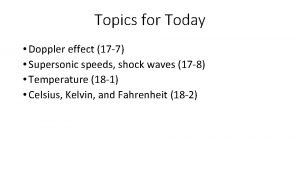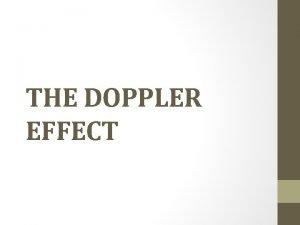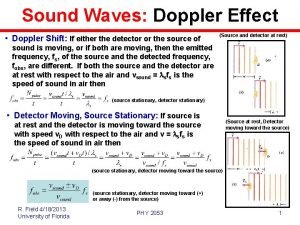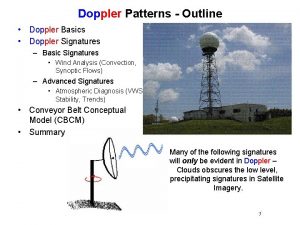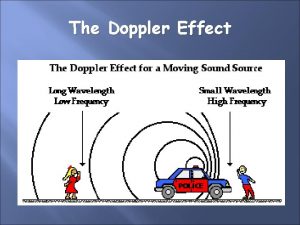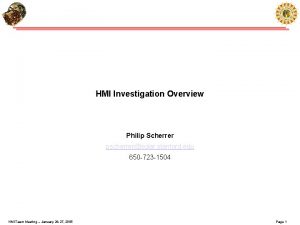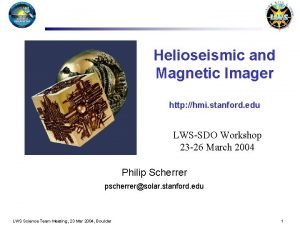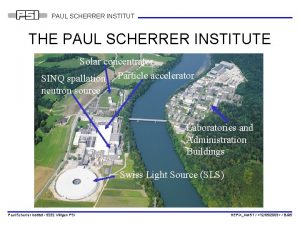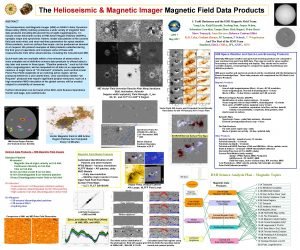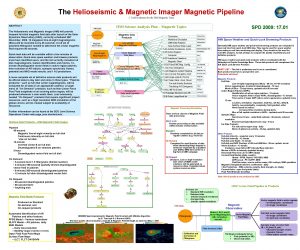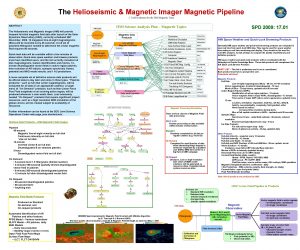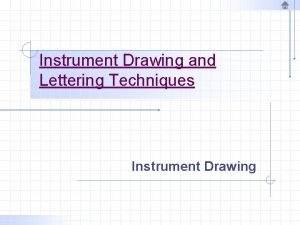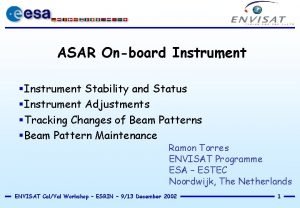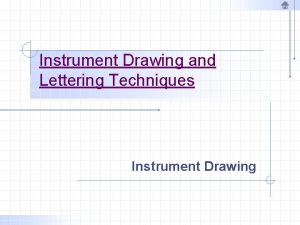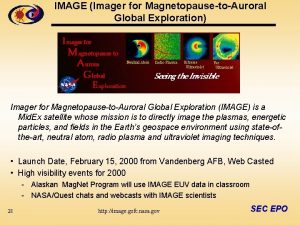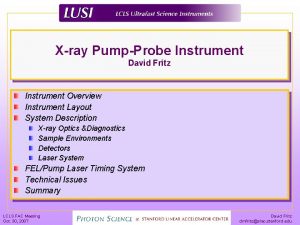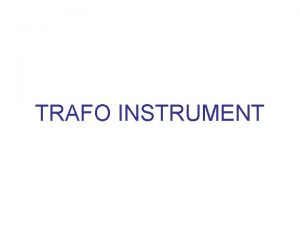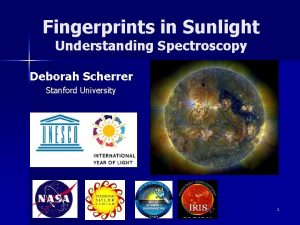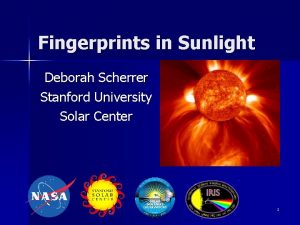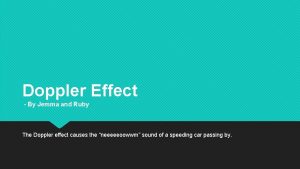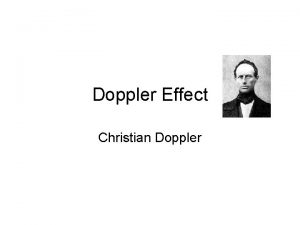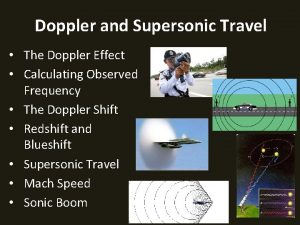Magnetic and Doppler Imager Instrument Philip Scherrer Stanford





















- Slides: 21

Magnetic and Doppler Imager Instrument Philip Scherrer Stanford University pscherrer@solar. stanford. edu With Input from Jesper Schou MPS L-5 Workshop, Dec 2014 Page 1 of 21

Outline Brief science comments Some Helioseismology background Notes about magnetographs L-5 Workshop, Dec 2014 Page 2 of 21

Deep Focused Time-Distance Helioseismology Figure from Decadal Strategy document shows longitudinal separation needed for ray paths with lower turning points appropriate to examine the base of the convection zone. Next figure shows which modes contribute. L-5 Workshop, Dec 2014 Page 3 of 21

Lower turning points Only lower degree modes penetrate into the radiative zone High degree modes only sample the near surface region Where c is sound speed, c = w/k. We can separate radial and horizontal components of k as |k|2 = kr 2 + kh 2. Lower turning point is where radial part of wavenumber kr vanishes. Using the relation kh 2 = l(l+1)/r we see that rt 2 = l(l+1) c 2 (rt)/w 2. Thus deeper with increasing frequency and lower l. L-5 Workshop, Dec 2014 Page 4 of 21

Time Distance Diagram Note 50 degree distance c. 90 minutes 180 degrees is 2 hours http: //solarphysics. livingreviews. org/open? pub. No=lrsp-20056& page=articlesu 12. html L-5 Workshop, Dec 2014 Giles, P. Dissertation, 1999 Page 5 of 21

Solar Sound Speed vs Depth Tachocline 225 km/s Surface 7 km/s So a perturbation at bottom of CZ makes a tiny contribution to the 90 minute travel time! From JCD, Note the kink at 0. 713 – this is the base of the convection zone L-5 Workshop, Dec 2014 Page 6 of 21

Science Opportunities No argument about need for regular cadence of c. 4 -arc-sec resolution magnetograms. MDI-like. A case has been made for helioseismology at least in an early science phase of a mission that may well evolve to an operational mode when or shortly after getting on station. For both of these any location from 30 degrees lag to 120 degrees would be good, nothing special about stopping at L 5 for the science goals so long as any drift is slow. For magnetic studies and seismology several studies are made possible by either a stereo or a large longitude dualmeasurement configuration, in addition to the obvious space weather and solar cycle studies. L-5 Workshop, Dec 2014 Page 7 of 21

Some stereo view science benefits • Seismology: Help to understand how to correct for viewangle systematic errors in apparently all existing near limb measurements such as are needed for deep nonrotation flows. Signals in the c. 1 second travel time difference (phase change of few tenths %). Errors that must be corrected are not well understood are several times larger. • Magnetograms: Improve methods for single site vector magnetograms by confirmation from alternate vantage point. Also improve understanding of weak near horizontal fields. Vector field methods fail for weak fields. • combined magnetograms and seismology in magnetic regions to study systemmatic phase errors in seismic measurements in the presence of fields with varying direction. L-5 Workshop, Dec 2014 Page 8 of 21

Extended longitude range of combined observations Deep probing of large scale flows. Zonal structure and largest scale convective rolls in deepest convection zone. Observation time scales of weeks may be sufficient although more likely need several passages of each longitude bin to get long enough span to get past near surface convective noise. Expect to need near continuous for many months or several years to get statistical limits to such flows. If L-5 or greater and can observe along meridians separated by 180 degrees to probe meridional flows at high latitudes. This will take multiple rotations of quiet sun to sort out. 2019 - 2021 or so may be good for this. L-5 Workshop, Dec 2014 Page 9 of 21

Magnetogram + Doppler Requirements • Note that Doppler and field are via the same measurements (Vlcp and Vrcp). • LOS Magnetograms at 1024 x 1024 pixels. • Critically sampled images • V, and M-los. No vector field (largely a telemetry issue) • Magnetograms at 1 -hour or so depending on bandwidth (2 k bps) • Doppler 256 x 256 pixels at 60 s or better cadence (5 kbps) • Intensity available if bandwidth OK. MDI downlinked only an annulus at the limb. L-5 Workshop, Dec 2014 Page 10 of 21

Requirements – Assumptions and Implications • Doppler continuously available at resolution good enough for global modes. – MDI did 200 x 200 cropped at 0. 9 R. 256 x 256 crop at limb would be better. – Adequate for tachocline and meridional flows – Needs 60 s cadence or better. 5 -6 kbps. • Magnetogram resolution and cadence? – 1. MDI did one every 96 minutes. – Enough forecasting? 30 minutes enough? – Need about 5 Mb, so 1. 3 kbps works for 1 -hour cadence. – Photospheric line preferred for LOS for more predictable center-limb variation. • Implications: – 2” pixels/4” resolution (lambda/D) – 32 mm aperture – Assumed 12 micron pixels. Not a major driver – Onboard observables calculation and compression • Like MDI, but unlike HMI • More complex data processing – Orbit LOS velocity can impact instrument details. L-5 Workshop, Dec 2014 Page 11 of 21

Instruments Telescope + polarization analyzer + filter + camera Lyot+Michelsons filter as for MDI, HMI - like designs have 15 years and almost 5 -years respectively of continuous measurements with no failures (yet) that impact the design science goals. Other technologies are possible, MOF and Fabry-Perot instead of Lyot + Michelsons, but these have not been flown (yet). Each has requirements on the spacecraft such as ability to have high magnetic fields (MOF) and thermal stability (F-P). MOF lines high in atmosphere. All three methods need similar telecentric optics to ensure same range of angles in the filters for each point on the field. All three need pointing stability over time to obtain the needed exposures for each measurement set. All need blocking filters for IR, UV, and most visible. L-5 Workshop, Dec 2014 Page 12 of 21

Mini-MDI Instrument Concept • Shrink HMI • Simple proven design. HMI in turn based on MDI – High TRL (>=7) – Same line as HMI (Fe. I 6173). Could be changed. • Lower resolution (4” vs. 1”) results in smaller aperture. – Lyot filter length does not reduce, so reduction limited – Main mass driver • Fewer pixels (1024 x 1024 vs. 4096 x 4096) – Smaller image. Shorter EFL. – Note: Same photons/s/pixel at fixed pixel size when critically sampled • Data processing electronics needed – No design done. Probably doable with standard processor. L-5 Workshop, Dec 2014 Page 13 of 21

L-5 Workshop, Dec 2014 Page 14 of 21

HMI Optical Path ISS Mirror Beam Control Lens ¼ Waveplate ½ Waveplates Aperture Stop Blocking Filter Wideband Michelson Secondary Lens Telecentric Lens Lyot Polarizer Tuning ½ Waveplates Narrowband Michelson BDS Beamsplitter Calibration Lenses and Focus Blocks Primary Lens ISS Beamsplitter and Limb Tracker Assembly Relay Lenses Front Window Filter Front CCD Shutter Assemblies Side CCD Fold Mirror L-5 Workshop, Dec 2014 Page 15 of 21

Very High TRL L-5 Workshop, Dec 2014 Page 16 of 21

HMI Layout Size: 1050 mm x 465 mm L-5 Workshop, Dec 2014 Page 17 of 21

Ma. DI – Possible Layout Size: 235 mm x 117 mm L-5 Workshop, Dec 2014 Page 18 of 21

Resources • Mass: – Optics package: 3. 5 kg based on scaling of HMI (47 kg) – Electronics: 10 kg is likely conservative. 5 kg likely. (HMI 19 kg) • Depends on how computing power is made available – Cables: 1. 5 kg (HMI 7 kg) – Total: 15 kg (10 kg likely) (HMI 73 kg) • Power – Camera: 1. 5 W. Less for CMOS based system. Scaled by pixels from HMI (30 W). – Optics package/thermal control: 2 W – Based on surface area. (HMI 29 W) – Electronics package: 22. 5 W. Half HMI (45 W). Likely overkill. – Total: 26 W. Likely much lower. (HMI 95 W) • Data rate (compressed) – MDI Medium-l plus magnetograms 7 kbit/s. 10 kbit/s will reduce shortcomings. • 5 kbit/s for 60 s Dopplergram • 2 kb/s for one full disk 1024 x 1024 magnetogram per hour. – 1024 x 1024 V+M at 60 s all the time is of order 70 -100 kbit/s • Depends strongly on desired noise level • Depends on more complex (lossless) compression than did MDI L-5 Workshop, Dec 2014 Page 19 of 21

Resources - Issues • Optics package mass based on simple scaling – But not a major driver – Assume smaller mechanisms than previously • Electronics package mass is poorly estimated • Power consumption is poorly estimated • Data rate is highly assumption dependent • Little redundancy in present design – Easy to add • Other designs possible – Larger orbit velocity range can be accommodated with one additional rotating waveplate as in HMI. (MDI design OK for L-1) – Eg. MOF (JPL for Safari (L 3) / SPI (near polar)) • Simpler from an optical point of view • Some dynamic range issues. Unlikely to be a problem here due to low eccentricity. • Lower TRL (6). Never flown – Fourier Tachometer. Similar to design presented but a bit simpler and noisier • L-5 Workshop, Dec 2014 APS sensors may help here Page 20 of 21

Conclusion • Very doable instrument – Smaller version of MDI/HMI • Low mass and power – Substantial reduction likely possible • No technical issues • Two existing versions, MDI and HMI have worked OK for 15 and ~5 years resp. , both still fully operational. L-5 Workshop, Dec 2014 Page 21 of 21
 Philip scherrer
Philip scherrer Dr philip scherrer
Dr philip scherrer Solar center stanford
Solar center stanford Mirjana pavlovic
Mirjana pavlovic еele
еele Photosystems
Photosystems Lightning imager
Lightning imager Ftk imager
Ftk imager Coercivity
Coercivity Wb flux
Wb flux Magnetic moment and magnetic field relation
Magnetic moment and magnetic field relation F=i(lxb)
F=i(lxb) Passive and active instruments
Passive and active instruments An mti radar that uses amplitude fluctuations is
An mti radar that uses amplitude fluctuations is Delay line canceller in radar
Delay line canceller in radar Difference between doppler and duplex
Difference between doppler and duplex Duplex ultrasound vs doppler
Duplex ultrasound vs doppler Laser doppler electrophoresis
Laser doppler electrophoresis Onde trasversali e longitudinali zanichelli
Onde trasversali e longitudinali zanichelli Mach cone
Mach cone Doppler effect when to add or subtract
Doppler effect when to add or subtract Doppler effect
Doppler effect
